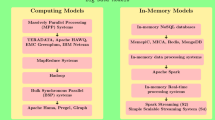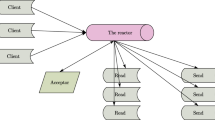Abstract
Cluster, consisting of a group of computers, is to act as a whole system to provide users with computer resources. Each computer is a node of this cluster. Cluster computer refers to a system consisting of a complete set of computers connected to each other. With the rapid development of computer technology, cluster computing technique with high performance–cost ratio has been widely applied in distributed parallel computing. For the large-scale close data in group enterprise, a heterogeneous data integration model was built under cluster environment based on cluster computing, XML technology and ontology theory. Such model could provide users unified and transparent access interfaces. Based on cluster computing, the work has solved the heterogeneous data integration problems by means of Ontology and XML technology. Furthermore, good application effect has been achieved compared with traditional data integration model. Furthermore, it was proved that this model improved the computing capacity of system, with high performance–cost ratio. Thus, it is hoped to provide support for decision-making of enterprise managers.



Similar content being viewed by others
References
Deng, W.: Scheduling for computer cluster based on cloud computing and fuzzy clustering. Comput. Meas. Control 21(9), 2529–2531 (2013)
Tian, H., Bian, J.C., Yao, H.: Parallelization of the semi-lagrangian shallow-water model using MPI techniques. J. Appl. Meteorol. Sci. 15(4), 417–426 (2004)
Zhao, G.: Cluster computing technique and its application to the petroleum industry. Geophys. Prospect. Pet. 40(3), 118–126 (2001)
Yao, Y.P., Zhang, Y.X.: A solution for analytic simulation based on parallel processing. J. Syst. Simul. 20(24), 6617–6621 (2008)
Taher, A.G.: Techniques and countermeasures of website/wireless traffic analysis and fingerprinting. Cluster Comput. (2015). doi:10.1007/s10586-015-0502-4
Abiteboul, S., Benjelloun, O., Milo, T.: Web Services and Data Integration. In: Third International Conference on Web Information Systems Engineering (WISE 2002), IEEE Computer Society, pp. 3–7. (2002)
Cal, Andrea, Calvanese, Diego: Data integration under integrity constraints. Inf. Syst. 29, 147–163 (2004)
Jeffrey, D.: Ullman: information integration using logical views. Lect. Notes Comput. Sci. 1186, 19–40 (1997)
Chen, Zhiyuan, Li, Chen, Pei, Jian, et al.: Recent progress on selected topics in database research. J. Comput. Sci. Technol. 18(5), 538–552 (2003)
Li Rui-xuan, Lu, Wei, Zheng-ding, Wu, Wei-jun, Xiao: Integrating XML with CORBA-based multidatabase systems. Wuhan Univ. J. Nat. Sci. 9(5), 676–680 (2004)
Halevy, A.Y., Ives, Z.G., et al.: Schema Mediation in Peer Data Management Systems. In: 19th International Conference on Data Engineering (ICDE 2003), IEEE Computer Society, pp. 505–518. (2003)
Wang, L.Z., Samee, U.K.: Review of performance metrics for green data centers’ a taxonomy study. J. Supercomput. 63(3), 639–656 (2013)
Maier, A., Oberhofer, M., Schwarz, T.: Industrializing data integration projects using a metadata driven assembly line. Inf. Technol. 54(3), 114–122 (2012)
Calì, A., Lembo, D.: On the Decidability and Complexity of Query Answering over Inconsistent and Incomplete Databases. In: Proceedings of the PODS 2003. San Diego: ACM Press, pp. 260–271. (2003)
Borst, W.N.: Construction of Engineering Ontologies for Knowledge Sharing and Reuse. PhD thesis, University of Twente, Enschede (1997)
Klingner, C.M., Brodoehl, S., Huonker, R., Götz, T., Baumann, L.: Parallel processing of somatosensory information: evidence from dynamic causal modeling of MEG data. Neuroimage 118, 193–198 (2015)
Freeman, J., Vladimirov, N., Kawashima, T.: Mapping brain activity at scale with cluster computing. Nat. Methods 11(9), 941–950 (2014)
Panetto, H., Cecil, J.: Information systems for enterprise integration, interoperability and networking: theory and applications. Enterp. Inf. Syst. 7, 1–6 (2013)
Sujansky, W.: Heterogeneous database integration in biomedicine. Comput. Biomed. Res. 34, 285–298 (2001)
Mourtzis, D., Maropoulos, P., Chryssolouris, G.: Digital enterprise technology: systems and methods for the digital modelling and analysis of the global product development and realisation process. Int. J. Comput. Integr. Manuf. 28, 1–2 (2015)
Jardim-Goncalves, R., Grilo, A., Agostinho, C., Lampathaki, F., Charalabidis, Y.: Systematisation of Interoperability body of knowledge: the foundation for enterprise interoperability as a science. Enterp. Inf. Syst. 7, 7–32 (2013)
Di Guglielmo, L., Fummi, F., Pravadelli, G., Stefanni, F., Vinco, S.: UNIVERCM: the UNIversal VERsatile computational model for heterogeneous system integration. IEEE Trans. Comput. 62, 225–241 (2013)
Gahleitner, E., Wöß, W.: Enabling Distribution and Reuse of Ontology Mapping Information for Semantically Enriched Communication Services. In: Proceedings of the Database and Expert Systems Applications, 15th International Workshop, IEEE Computer Society, Washington, DC, USA, 2004, pp. 116–121
Jung, J-y, Kim, H., Kang, S.-H.: Standards-based approaches to B2B workflow integration. Comput. Ind. Eng. 51(2), 321–334 (2006). (Special Issue: Logistics and Supply Chain Management)
Matthias, F., Christian, Z., David, T.: Lifting XML schema to OWL. In: Koch, N., Fraternali, P., Wirsing, M. (eds.) Web Engineering–4\(^{th}\) International Conference, ICWE 2004, Munich, Germany, July 26–30, 2004, pp. 354–358. Proceedings, Springer, Heidelberg (2004)
Ehrig, E., Sure, Y.: FOAM–Framework for Ontology Slignment and Mapping; Results of the Ontology Alignment Initiative. In: Ashpole, B., Ehrig, M., Euzenat, J., Stuckenschmidt, H. (eds.) Proceedings of the Workshop on Integrating Ontologies, vol. 156, October 2005, pp. 72–76, CEURWS.org
Metzger, M., Polakow, G.: A survey on applications of agent technology in industrial process control. IEEE Trans. Ind. Inf. 7, 570–581 (2011)
Fang, J., Qu, T., Li, Z., Xu, G., Huang, G.O.: Agent-based gateway operating system for RFID-enabled ubiquitous manufacturing enterprise. Comput. Int. Manuf. 29, 222–231 (2013)
Jin, X., Jie, L.: A study of multi-agent based model for urban intelligent transport systems. Int. J. Adv. Comput. Technol. 4, 126–134 (2012)
Chan, C.-K., Chow, H.K., So, S.K., Chan, H.C.: Agent-based flight planning system for enhancing the competitiveness of the air cargo industry. Exp. Syst. Appl. 39, 11325–11334 (2012)
Rodríguez, S., De Paz, J.F., Villarrubia, G., Zato, C., Bajo, J., Corchado, J.M.: Multiagent information fusion system to manage data from a WSN in a residential home. Inf. Fusion 23, 43–57 (2015)
Xu, Z., et al.: Crowdsourcing based description of urban emergency events using social media big data. IEEE Trans. Cloud Comput. doi:10.1109/TCC.2016.2517638
Xu, Z., et al.: Crowdsourcing based social media data analysis of urban emergency events. Multimed. Tools Appl. doi:10.1007/s11042-015-2731-1
Xu, Z., et al.: Participatory sensing based semantic and spatial analysis of urban emergency events using mobile social media. EURASIP J. Wirel. Commun. Netw. 61, 44–56 (2016)
Xu, Z., et al.: Building knowledge base of urban emergency events based on crowdsourcing of social media. Concurr. Comput. doi:10.1002/cpe.3780
Author information
Authors and Affiliations
Corresponding author
Rights and permissions
About this article
Cite this article
Zhou, Q. Research on heterogeneous data integration model of group enterprise based on cluster computing. Cluster Comput 19, 1275–1282 (2016). https://doi.org/10.1007/s10586-016-0580-y
Received:
Revised:
Accepted:
Published:
Issue Date:
DOI: https://doi.org/10.1007/s10586-016-0580-y




